英语中有19种修辞手法及英国文学作品与作家
英语中的修辞手法
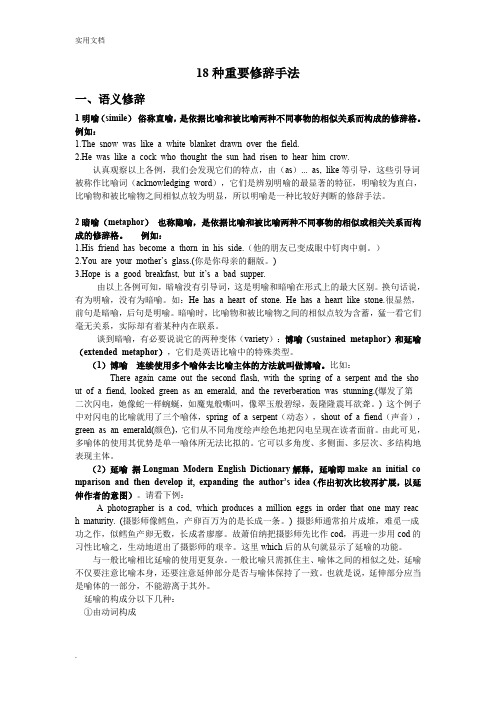
18种重要修辞手法一、语义修辞1明喻(simile)俗称直喻,是依据比喻和被比喻两种不同事物的相似关系而构成的修辞格。
例如:1.The snow was like a white blanket drawn over the field.2.He was like a cock who thought the sun had risen to hear him crow.认真观察以上各例,我们会发现它们的特点,由(as)... as, like等引导,这些引导词被称作比喻词(acknowledging word),它们是辨别明喻的最显著的特征,明喻较为直白,比喻物和被比喻物之间相似点较为明显,所以明喻是一种比较好判断的修辞手法。
2暗喻(metaphor)也称隐喻,是依据比喻和被比喻两种不同事物的相似或相关关系而构成的修辞格。
例如:1.His friend has become a thorn in his side.(他的朋友已变成眼中钉肉中刺。
)2.You are your mother’s glass.(你是你母亲的翻版。
)3.Hope is a good br eakfast, but it’s a bad supper.由以上各例可知,暗喻没有引导词,这是明喻和暗喻在形式上的最大区别。
换句话说,有为明喻,没有为暗喻。
如:He has a heart of stone. He has a heart like stone.很显然,前句是暗喻,后句是明喻。
暗喻时,比喻物和被比喻物之间的相似点较为含蓄,猛一看它们毫无关系,实际却有着某种内在联系。
谈到暗喻,有必要说说它的两种变体(variety):博喻(sustained metaphor)和延喻(extended metaphor),它们是英语比喻中的特殊类型。
(1)博喻连续使用多个喻体去比喻主体的方法就叫做博喻。
比如:There again came out the second flash, with the spring of a serpent and the sho ut of a fiend, looked green as an emerald, and the reverberation was stunning.(爆发了第二次闪电,她像蛇一样蜿蜒,如魔鬼般嘶叫,像翠玉般碧绿,轰隆隆震耳欲聋。
英语18种重要修辞手法
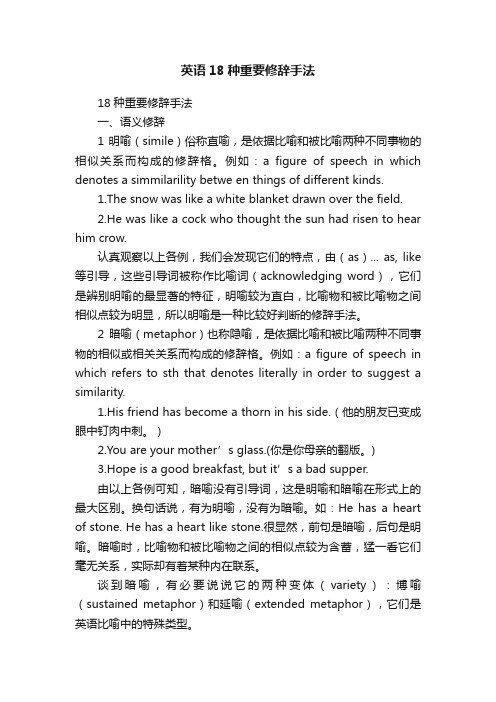
英语18种重要修辞手法18种重要修辞手法一、语义修辞1明喻(simile)俗称直喻,是依据比喻和被比喻两种不同事物的相似关系而构成的修辞格。
例如:a figure of speech in which denotes a simmilarility betwe en things of different kinds.1.The snow was like a white blanket drawn over the field.2.He was like a cock who thought the sun had risen to hear him crow.认真观察以上各例,我们会发现它们的特点,由(as)... as, like 等引导,这些引导词被称作比喻词(acknowledging word),它们是辨别明喻的最显著的特征,明喻较为直白,比喻物和被比喻物之间相似点较为明显,所以明喻是一种比较好判断的修辞手法。
2暗喻(metaphor)也称隐喻,是依据比喻和被比喻两种不同事物的相似或相关关系而构成的修辞格。
例如:a figure of speech in which refers to sth that denotes literally in order to suggest a similarity.1.His friend has become a thorn in his side.(他的朋友已变成眼中钉肉中刺。
)2.You are your mother’s glass.(你是你母亲的翻版。
)3.Hope is a good bre akfast, but it’s a bad supper.由以上各例可知,暗喻没有引导词,这是明喻和暗喻在形式上的最大区别。
换句话说,有为明喻,没有为暗喻。
如:He has a heart of stone. He has a heart like stone.很显然,前句是暗喻,后句是明喻。
英语文学中得修辞手法

一、明喻(simile)是以两种具有相同特征的事物和现象进行对比,表明本体和喻体之间的相似关系,两者都在对比中出现。
常用比喻词like, as, as if, as though等,补充:二、隐喻(metaphor)这种比喻不通过比喻词进行,而是直接将用事物当作乙事物来描写,甲乙两事物之间的联系和相似之处是暗含的。
补充:三、提喻(synecdoche)又称举隅法,主要特点是局部代表全体,或以全体喻指部分,或以抽象代具体,或以具体代抽象。
四、拟人(personification)这种修辞方法是把人类的特点、特性加于外界事物之上,使之人格化,以物拟人,以达到彼此交融,合二为一。
五、夸张(hyperbole)这是运用丰富的想象,过激的言词,渲染和装饰客观事物,以达到强调的效果。
六、叠言(rhetorical repetition)这种修辞法是指在特定的语境中,将相同的结构,相同意义词组成句子重叠使用,以增强语气和力量。
七、借代(metonymy)是指两种不同事物并不相似,但又密不可分,因而常用其中一种事物名称代替另一种。
八、双关语(pun)是以一个词或词组,用巧妙的办法同时把互不关联的两种含义结合起来,以取得一种诙谐有趣的效果。
九、拟声(onomatcpocia)是摹仿自然界中非语言的声音,其发音和所描写的事物的声音很相似,使语言显得生动,富有表现力。
十、讽刺(irony)是指用含蓄的褒义词语来表示其反面的意义,从而达到使本义更加幽默,更加讽刺的效果。
十一、通感(synesthesia)是指在某个感官所产生的感觉,转到另一个感官的心理感受。
十二、头韵法(alliteration)在文句中有两个以上连结在一起的词或词组,其开头的音节有同样的字母或声音,以增强语言的节奏感。
英语修辞手法1) Simile:(明喻)It is a figure of speech which makes a comparison between two unlike elements having at least one quality or characteristic (特性)in common. To make the comparison, words like as, as...as, as if and like are used to transfer the quality we associate with one to the other. For example, As cold waters to a thirsty soul, so is good news from a far country./ This elephant is like a snake as anybody can see.2) Metaphor:(暗喻)It is like a simile, also makes a comparison between two unlike elements, but unlike a simile, this comparison is implied rather than stated. For example, the world is a stage./ The diamond department was the heart and center of the store.3) Analogy: (类比)It is also a form of comparison, but unlike simile or metaphor which usually uses comparison on one point of resemblance, analogy draws a parallel between two unlike things that have several common qualities or points of resemblance.4) Personification: (拟人)It gives human form of feelings to animals, or life and personal attributes(赋予) to inanimate(无生命的) objects, or to ideas and abstractions(抽象). For example, the wind whistled through the trees.5) Hyperbole: (夸张)It is the deliberate use of overstatement or exaggeration to achieve emphasis. For instance, he almost died laughing.6) Understatement: (含蓄陈述)It is the opposite of hyperbole, or overstatement. It achieves its effect of emphasizing a fact by deliberately(故意地) understating it, impressing the listener or the reader more by what is merely implied or left unsaid than by bare statement. For instance, It is no laughing matter.7) Euphemism: (委婉)It is the substitution of an agreeable or inoffensive(无冒犯) expression for one that may offend or suggest something unpleasant. For instance, we refer to "die" as” pass away".8) Metonymy (转喻)It is a figure of speech that has to do with the substitution of the mane of one thing for that of another. For instance, the pen (words) is mightier than the sword (forces). 借代(metonymy)是指两种不同事物并不相似,但又密不可分,因而常用其中一种事物名称代替另一种。
英语中所有19种修辞手法的全数解释和例句
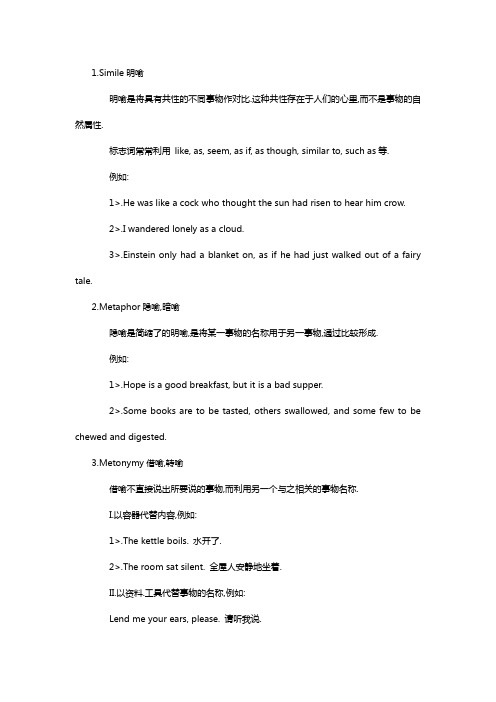
1.Simile明喻明喻是将具有共性的不同事物作对比.这种共性存在于人们的心里,而不是事物的自然属性.标志词常常利用like, as, seem, as if, as though, similar to, such as等.例如:1>.He was like a cock who thought the sun had risen to hear him crow.2>.I wandered lonely as a cloud.3>.Einstein only had a blanket on, as if he had just walked out of a fairy tale.2.Metaphor隐喻,暗喻隐喻是简缩了的明喻,是将某一事物的名称用于另一事物,通过比较形成.例如:1>.Hope is a good breakfast, but it is a bad supper.2>.Some books are to be tasted, others swallowed, and some few to be chewed and digested.3.Metonymy借喻,转喻借喻不直接说出所要说的事物,而利用另一个与之相关的事物名称.I.以容器代替内容,例如:1>.The kettle boils. 水开了.2>.The room sat silent. 全屋人安静地坐着.II.以资料.工具代替事物的名称,例如:Lend me your ears, please. 请听我说.III.以作者代替作品,例如:a complete Shakespeare 莎士比亚全集VI.以具体事物代替抽象概念,例如:I had the muscle, and they made money out of it. 我有力气,他们就用我的力气赚钱.4.Synecdoche提喻提喻用部份代替全部,或用全部代替部份,或特殊代替一般.例如:1>.There are about 100 hands working in his factory.(部份代整体)他的厂里约有100名工人.2>.He is the Newton of this century.(特殊代一般)他是本世纪的牛顿.3>.The fox goes very well with your cap.(整体代部份)这狐皮围脖与你的帽子很相配.5.Synaesthesia通感,联觉,移觉这种修辞法是以视.听.触.嗅.味等感觉直接描述事物.通感就是把不同感官的感觉沟通起来,借联想引发感觉转移,“以感觉写感觉”。
(完整版)英语中的修辞手法
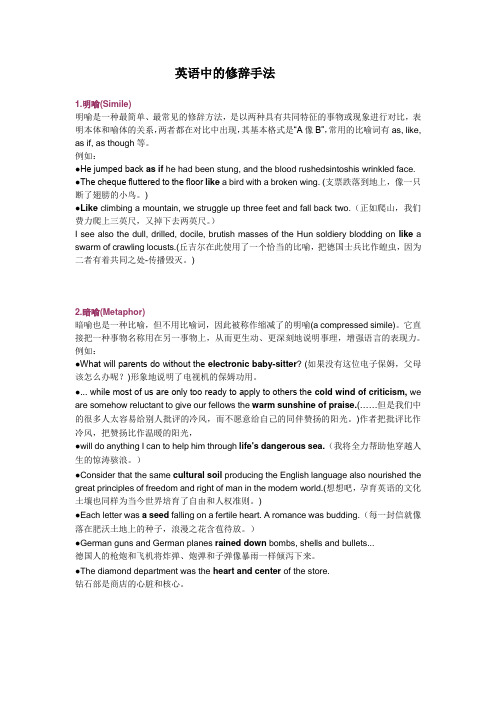
英语中的修辞手法1.明喻(Simile)明喻是一种最简单、最常见的修辞方法,是以两种具有共同特征的事物或现象进行对比,表明本体和喻体的关系,两者都在对比中出现,其基本格式是“A像B”,常用的比喻词有as, like, as if, as though等。
例如:●He jumped back as if he had been stung, and the blood rushedsintoshis wrinkled face.●The cheque fluttered to the floor like a bird with a broken wing. (支票跌落到地上,像一只断了翅膀的小鸟。
)●Like climbing a mountain, we struggle up three feet and fall back two.(正如爬山,我们费力爬上三英尺,又掉下去两英尺。
)I see also the dull, drilled, docile, brutish masses of the Hun soldiery blodding on like a swarm of crawling locusts.(丘吉尔在此使用了一个恰当的比喻,把德国士兵比作蝗虫,因为二者有着共同之处-传播毁灭。
)2.暗喻(Metaphor)暗喻也是一种比喻,但不用比喻词,因此被称作缩减了的明喻(a compressed simile)。
它直接把一种事物名称用在另一事物上,从而更生动、更深刻地说明事理,增强语言的表现力。
例如:●What will parents do without the electronic baby-sitter? (如果没有这位电子保姆,父母该怎么办呢?)形象地说明了电视机的保姆功用。
●... while most of us are only too ready to apply to others the cold wind of criticism, we are somehow reluctant to give our fellows the warm sunshine of praise.(……但是我们中的很多人太容易给别人批评的冷风,而不愿意给自己的同伴赞扬的阳光。
英语18种重要修辞手法

18种重要修辞手法一、语义修辞1明喻(simile)俗称直喻,是依据比喻和被比喻两种不同事物的相似关系而构成的修辞格。
例如:a figure of speech in which denotes a simmilarility betwe en things of different kinds.1.The snow was like a white blanket drawn over the field.2.He was like a cock who thought the sun had risen to hear him crow.认真观察以上各例,我们会发现它们的特点,由(as)... as, like等引导,这些引导词被称作比喻词(acknowledging word),它们是辨别明喻的最显著的特征,明喻较为直白,比喻物和被比喻物之间相似点较为明显,所以明喻是一种比较好判断的修辞手法。
2暗喻(metaphor)也称隐喻,是依据比喻和被比喻两种不同事物的相似或相关关系而构成的修辞格。
例如:a figure of speech in which refers to sth that denotes literally in order to suggest a similarity.1.His friend has become a thorn in his side.(他的朋友已变成眼中钉肉中刺。
)2.You are your mother’s glass.(你是你母亲的翻版。
)3.Hope is a good breakfast, but it’s a bad supper.由以上各例可知,暗喻没有引导词,这是明喻和暗喻在形式上的最大区别。
换句话说,有为明喻,没有为暗喻。
如:He has a heart of stone. He has a heart like stone.很显然,前句是暗喻,后句是明喻。
英语18种重要修辞手法
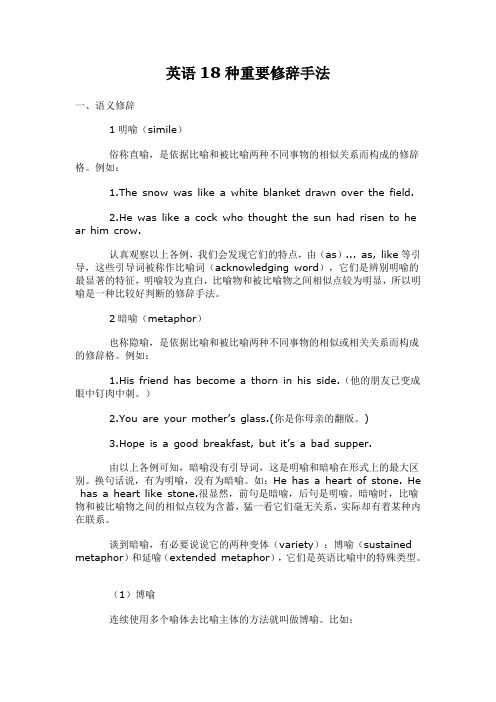
英语18种重要修辞手法一、语义修辞1明喻(simile)俗称直喻,是依据比喻和被比喻两种不同事物的相似关系而构成的修辞格。
例如:1.The snow was like a white blanket drawn over the field.2.He was like a cock who thought the sun had risen to he ar him crow.认真观察以上各例,我们会发现它们的特点,由(as)... as, like等引导,这些引导词被称作比喻词(acknowledging word),它们是辨别明喻的最显著的特征,明喻较为直白,比喻物和被比喻物之间相似点较为明显,所以明喻是一种比较好判断的修辞手法。
2暗喻(metaphor)也称隐喻,是依据比喻和被比喻两种不同事物的相似或相关关系而构成的修辞格。
例如:1.His friend has become a thorn in his side.(他的朋友已变成眼中钉肉中刺。
)2.You are your mother’s glass.(你是你母亲的翻版。
)3.Hope is a good breakfast, but it’s a bad supper.由以上各例可知,暗喻没有引导词,这是明喻和暗喻在形式上的最大区别。
换句话说,有为明喻,没有为暗喻。
如:He has a heart of stone. He has a heart like stone.很显然,前句是暗喻,后句是明喻。
暗喻时,比喻物和被比喻物之间的相似点较为含蓄,猛一看它们毫无关系,实际却有着某种内在联系。
谈到暗喻,有必要说说它的两种变体(variety):博喻(sustained metaphor)和延喻(extended metaphor),它们是英语比喻中的特殊类型。
(1)博喻连续使用多个喻体去比喻主体的方法就叫做博喻。
比如:There again came out the second flash, with the spring of a serpent and the shout of a fiend, looked green as an emerald, and the reverberation was stunning.(爆发了第二次闪电,她像蛇一样蜿蜒,如魔鬼般嘶叫,像翠玉般碧绿,轰隆隆震耳欲聋。
英语22种修辞手法以及例句归纳总结
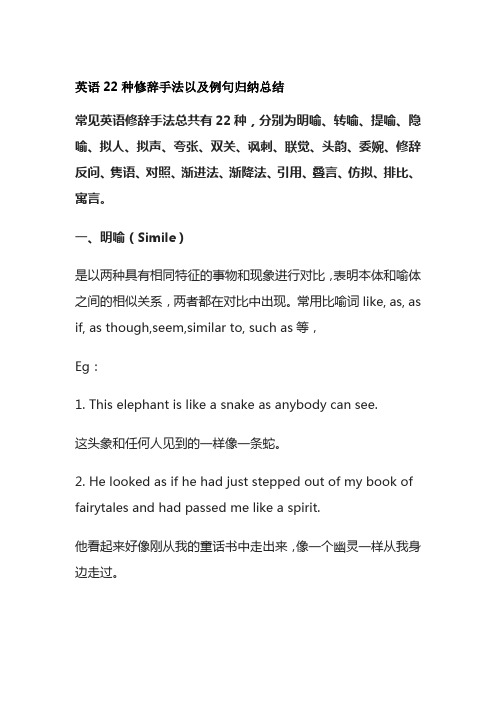
英语22种修辞手法以及例句归纳总结常见英语修辞手法总共有22种,分别为明喻、转喻、提喻、隐喻、拟人、拟声、夸张、双关、讽刺、联觉、头韵、委婉、修辞反问、隽语、对照、渐进法、渐降法、引用、叠言、仿拟、排比、寓言。
一、明喻(Simile)是以两种具有相同特征的事物和现象进行对比,表明本体和喻体之间的相似关系,两者都在对比中出现。
常用比喻词like, as, as if, as though,seem,similar to, such as等,Eg:1. This elephant is like a snake as anybody can see.这头象和任何人见到的一样像一条蛇。
2. He looked as if he had just stepped out of my book of fairytales and had passed me like a spirit.他看起来好像刚从我的童话书中走出来,像一个幽灵一样从我身边走过。
3. It has long leaves that sway in the wind like slim fingers reaching to touch something.它那长长的叶子在风中摆动,好像伸出纤细的手指去触摸什么东西似的。
二、隐喻(Metaphor)这种比喻不通过比喻词进行,而是直接将用事物当作乙事物来描写,甲乙两事物之间的联系和相似之处是暗含的。
Eg:1、The diamond department was the heart and center of the store.钻石部是商店的心脏和核心。
2. He is a pig.他简直是头猪。
(比喻:他是一个像猪一般的人,指肮脏,贪吃的人。
)3. She is a woman with a stony heart.她是一个铁石心肠的女人。
(比喻:这个女人冷酷无情。
)4.Mark Twain is a mirror of America.马克•吐温是美国的一面镜子。
英语19种修辞手法的全部解释和例句
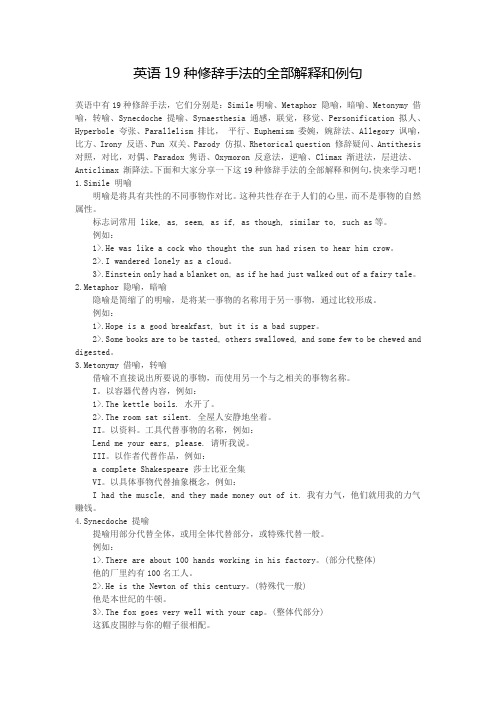
英语19种修辞手法的全部解释和例句英语中有19种修辞手法,它们分别是:Simile明喻、Metaphor 隐喻,暗喻、Metonymy 借喻,转喻、Synecdoche 提喻、Synaesthesia 通感,联觉,移觉、Personification 拟人、Hyperbole 夸张、Parallelism 排比,平行、Euphemism 委婉,婉辞法、Allegory 讽喻,比方、Irony 反语、Pun 双关、Parody 仿拟、Rhetorical question 修辞疑问、Antithesis 对照,对比,对偶、Paradox 隽语、Oxymoron 反意法,逆喻、Climax 渐进法,层进法、Anticlimax 渐降法。
下面和大家分享一下这19种修辞手法的全部解释和例句,快来学习吧!1.Simile 明喻明喻是将具有共性的不同事物作对比。
这种共性存在于人们的心里,而不是事物的自然属性。
标志词常用 like, as, seem, as if, as though, similar to, such as等。
例如:1>.He was like a cock who thought the sun had risen to hear him crow。
2>.I wandered lonely as a cloud。
3>.Einstein only had a blanket on, as if he had just walked out of a fairy tale。
2.Metaphor 隐喻,暗喻隐喻是简缩了的明喻,是将某一事物的名称用于另一事物,通过比较形成。
例如:1>.Hope is a good breakfast, but it is a bad supper。
2>.Some books are to be tasted, others swallowed, and some few to be chewed and digested。
英语中19种修辞手法及解释
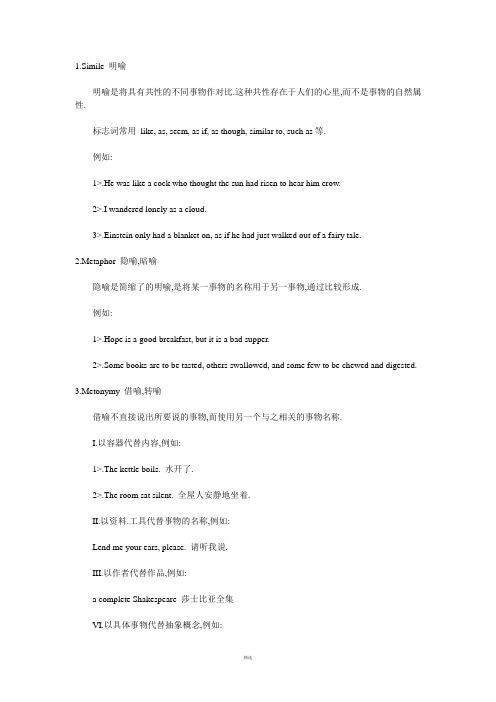
1.Simile 明喻明喻是将具有共性的不同事物作对比.这种共性存在于人们的心里,而不是事物的自然属性.标志词常用like, as, seem, as if, as though, similar to, such as等.例如:1>.He was like a cock who thought the sun had risen to hear him crow.2>.I wandered lonely as a cloud.3>.Einstein only had a blanket on, as if he had just walked out of a fairy tale.2.Metaphor 隐喻,暗喻隐喻是简缩了的明喻,是将某一事物的名称用于另一事物,通过比较形成.例如:1>.Hope is a good breakfast, but it is a bad supper.2>.Some books are to be tasted, others swallowed, and some few to be chewed and digested.3.Metonymy 借喻,转喻借喻不直接说出所要说的事物,而使用另一个与之相关的事物名称.I.以容器代替内容,例如:1>.The kettle boils. 水开了.2>.The room sat silent. 全屋人安静地坐着.II.以资料.工具代替事物的名称,例如:Lend me your ears, please. 请听我说.III.以作者代替作品,例如:a complete Shakespeare 莎士比亚全集VI.以具体事物代替抽象概念,例如:I had the muscle, and they made money out of it. 我有力气,他们就用我的力气赚钱.4.Synecdoche 提喻提喻用部分代替全体,或用全体代替部分,或特殊代替一般.例如:1>.There are about 100 hands working in his factory.(部分代整体)他的厂里约有100名工人.2>.He is the Newton of this century.(特殊代一般)他是本世纪的牛顿.3>.The fox goes very well with your cap.(整体代部分)这狐皮围脖与你的帽子很相配.5.Synaesthesia 通感,联觉,移觉这种修辞法是以视.听.触.嗅.味等感觉直接描写事物.通感就是把不同感官的感觉沟通起来,借联想引起感觉转移,“以感觉写感觉”。
英语中所有19种修辞手法的全部解释和例句
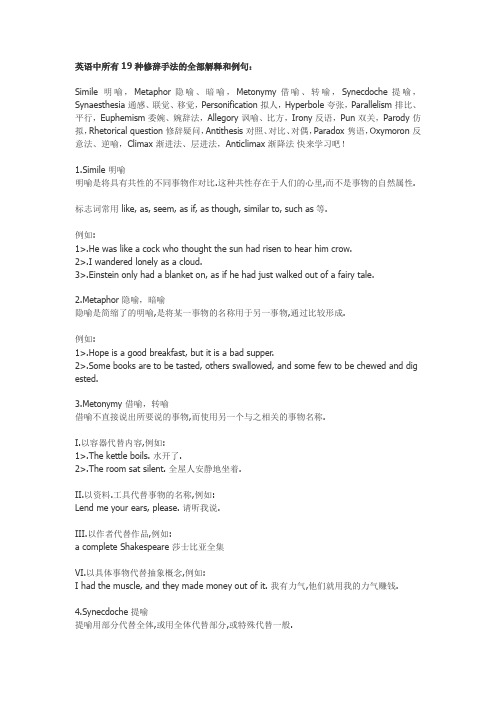
英语中所有19种修辞手法的全部解释和例句:Simile明喻,Metaphor 隐喻、暗喻,Metonymy 借喻、转喻,Synecdoche 提喻,Synaesthesia 通感、联觉、移觉,Personification 拟人,Hyperbole 夸张,Parallelism 排比、平行,Euphemism 委婉、婉辞法,Allegory 讽喻、比方,Irony 反语,Pun 双关,Parody 仿拟,Rhetorical question 修辞疑问,Antithesis 对照、对比、对偶,Paradox 隽语,Oxymoron 反意法、逆喻,Climax 渐进法、层进法,Anticlimax 渐降法快来学习吧!1.Simile 明喻明喻是将具有共性的不同事物作对比.这种共性存在于人们的心里,而不是事物的自然属性. 标志词常用 like, as, seem, as if, as though, similar to, such as等.例如:1>.He was like a cock who thought the sun had risen to hear him crow.2>.I wandered lonely as a cloud.3>.Einstein only had a blanket on, as if he had just walked out of a fairy tale.2.Metaphor 隐喻,暗喻隐喻是简缩了的明喻,是将某一事物的名称用于另一事物,通过比较形成.例如:1>.Hope is a good breakfast, but it is a bad supper.2>.Some books are to be tasted, others swallowed, and some few to be chewed and dig ested.3.Metonymy 借喻,转喻借喻不直接说出所要说的事物,而使用另一个与之相关的事物名称.I.以容器代替内容,例如:1>.The kettle boils. 水开了.2>.The room sat silent. 全屋人安静地坐着.II.以资料.工具代替事物的名称,例如:Lend me your ears, please. 请听我说.III.以作者代替作品,例如:a complete Shakespeare 莎士比亚全集VI.以具体事物代替抽象概念,例如:I had the muscle, and they made money out of it. 我有力气,他们就用我的力气赚钱.4.Synecdoche 提喻提喻用部分代替全体,或用全体代替部分,或特殊代替一般.例如:1>.There are about 100 hands working in his factory.(部分代整体)他的厂里约有100名工人.2>.He is the Newton of this century.(特殊代一般)他是本世纪的牛顿.3>.The fox goes very well with your cap.(整体代部分)这狐皮围脖与你的帽子很相配.5.Synaesthesia 通感,联觉,移觉这种修辞法是以视.听.触.嗅.味等感觉直接描写事物.通感就是把不同感官的感觉沟通起来,借联想引起感觉转移,“以感觉写感觉”。
英语中19种修辞手法和例句
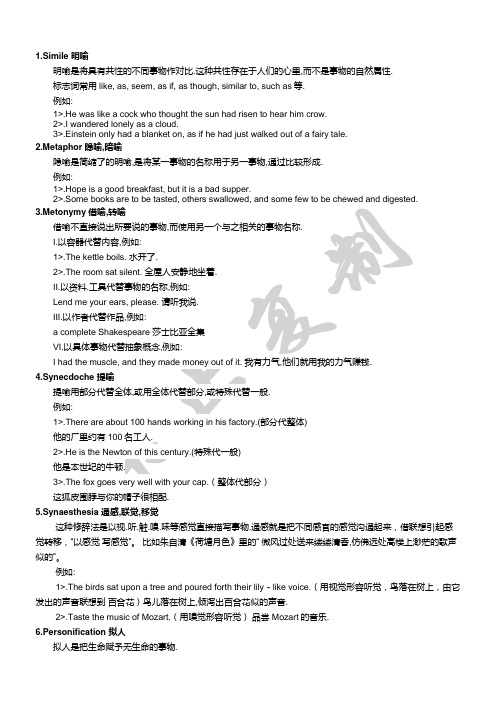
英语19种修辞手法的全部解释和例句

英语19种修辞手法的全部解释和例句修辞是能够让语言变得更加富有表达性的工具,同时也是让语言变得更加复杂的一种语言现象,了解修辞手法,能够让我们更加容易了解作者或者说话者想要来表达的情感和想法。
英语和汉语一样,也有着丰富的修辞手法。
今天我们来了解一下英语中的修辞手法,帮助我们更好的学习英语。
英语中有19种修辞手法,它们分别是:Simile明喻、Metaphor隐喻,暗喻、Metonymy借喻,转喻、Synecdoche 提喻、Synaesthesia通感,联觉,移觉、Personification拟人、Hyperbole夸张、Parallelism排比,平行、Euphemism委婉,婉辞法、Allegory讽喻,比方、Irony反语、Pun双关、Parody仿拟、Rhetoricalquestion修辞疑问、Antithesis对照,对比,对偶、Paradox隽语、Oxymoron反意法,逆喻、Climax渐进法,层进法、Anticlimax渐降法。
下面和大家一一介绍一下这19种修辞手法,同时也给出全部解释和例句:1、Simile明喻明喻是将具有共性的不同事物作对比.这种共性存在于人们的心里,而不是事物的自然属性. 标志词常用like,as,seem,as if,as though,similar to,such as 等. 例如: 1>.He was like a cock who thought the sun had risen to hear him crow. 2>.I wan dered lonely as a cloud. 3>.Einstein only had a blanket on, as if he had just walked ou t of a fairy tale.2.Metaphor隐喻,暗喻隐喻是简缩了的明喻,是将某一事物的名称用于另一事物,通过比较形成. 例如: 1>.Hope is a good breakfast, but it is a bad supper. 2>.Some books are to be taste d, others swallowed, and some few to be chewed and digested.3.Metonymy借喻,转喻借喻不直接说出所要说的事物,而使用另一个与之相关的事物名称. I.以容器代替内容,例如: 1>.The kettle boils. 水开了. 2>.The room sat silent. 全屋人安静地坐着. II.以资料.工具代替事物的名称,例如: Lend me your ears, please. 请听我说. III.以作者代替作品,例如: a complete Shakespeare 莎士比亚全集 VI.以具体事物代替抽象概念,例如: I had the muscle, and they made money out of it.我有力气,他们就用我的力气赚钱.4.Synecdoche提喻提喻用部分代替全体,或用全体代替部分,或特殊代替一般. 例如: 1>.There are about 100 hands working in his factory.(部分代整体) 他的厂里约有100名工人. 2>.He is the Newton of this century.(特殊代一般) 他是本世纪的牛顿. 3>.The fox goes very well with your cap.(整体代部分) 这狐皮围脖与你的帽子很相配.5.Synaesthesia通感,联觉,移觉这种修辞法是以视.听.触.嗅.味等感觉直接描写事物.通感就是把不同感官的感觉沟通起来,借联想引起感觉转移,“以感觉写感觉”。
英语中所有19种修辞手法的全部解释和例句
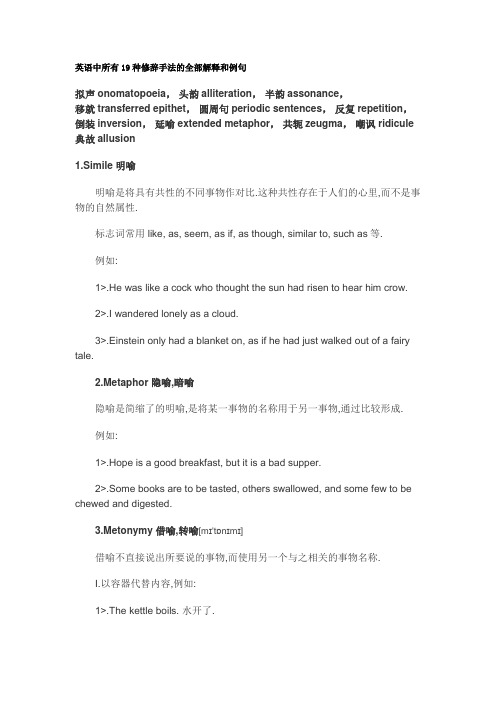
英语中所有19种修辞手法的全部解释和例句拟声onomatopoeia,头韵alliteration,半韵assonance,移就transferred epithet,圆周句periodic sentences,反复repetition,倒装inversion,延喻 extended metaphor,共轭zeugma,嘲讽 ridicule 典故allusion1.Simile 明喻明喻是将具有共性的不同事物作对比.这种共性存在于人们的心里,而不是事物的自然属性.标志词常用 like, as, seem, as if, as though, similar to, such as等.例如:1>.He was like a cock who thought the sun had risen to hear him crow.2>.I wandered lonely as a cloud.3>.Einstein only had a blanket on, as if he had just walked out of a fairy tale.2.Metaphor 隐喻,暗喻隐喻是简缩了的明喻,是将某一事物的名称用于另一事物,通过比较形成.例如:1>.Hope is a good breakfast, but it is a bad supper.2>.Some books are to be tasted, others swallowed, and some few to be chewed and digested.3.Metonymy 借喻,转喻[mɪ'tɒnɪmɪ]借喻不直接说出所要说的事物,而使用另一个与之相关的事物名称.I.以容器代替内容,例如:1>.The kettle boils. 水开了.2>.The room sat silent. 全屋人安静地坐着.II.以资料.工具代替事物的名称,例如:Lend me your ears, please. 请听我说.III.以作者代替作品,例如:a complete Shakespeare 莎士比亚全集VI.以具体事物代替抽象概念,例如:I had the muscle, and they made money out of it. 我有力气,他们就用我的力气赚钱.4.Synecdoche 提喻[sɪ'nekdəkɪ]提喻用部分代替全体,或用全体代替部分,或特殊代替一般.例如:1>.There are about 100 hands working in his factory.(部分代整体)他的厂里约有100名工人.2>.He is the Newton of this century.(特殊代一般)他是本世纪的牛顿.3>.The fox goes very well with your cap.(整体代部分)这狐皮围脖与你的帽子很相配.5.Synaesthesia 通感,联觉,移觉[,sɪnɪs'θiːzɪə]这种修辞法是以视.听.触.嗅.味等感觉直接描写事物.通感就是把不同感官的感觉沟通起来,借联想引起感觉转移,“以感觉写感觉”。
英语18种重要修辞手法

18种重要修辞手法一、语义修辞1明喻(simile)俗称直喻,是依据比喻和被比喻两种不同事物的相似关系而构成的修辞格。
例如:a figure of speech in which denotes a simmilarility betwe en things of different kinds.1.The snow was like a white blanket drawn over the field.2.He was like a cock who thought the sun had risen to hear him crow.认真观察以上各例,我们会发现它们的特点,由(as)... as, like等引导,这些引导词被称作比喻词(acknowledging word),它们是辨别明喻的最显著的特征,明喻较为直白,比喻物和被比喻物之间相似点较为明显,所以明喻是一种比较好判断的修辞手法。
2暗喻(metaphor)也称隐喻,是依据比喻和被比喻两种不同事物的相似或相关关系而构成的修辞格。
例如:a figure of speech in which refers to sth that denotes literally in order to suggest a similarity.1.His friend has become a thorn in his side.(他的朋友已变成眼中钉肉中刺。
)2.You are your mother’s glass.(你是你母亲的翻版。
)3.Hope is a good breakfast, but it’s a bad supper.由以上各例可知,暗喻没有引导词,这是明喻和暗喻在形式上的最大区别。
换句话说,有为明喻,没有为暗喻。
如:He has a heart of stone. He has a heart like stone.很显然,前句是暗喻,后句是明喻。
英语中19种修辞手法和例句

明喻明喻是将具有共性的不同事物作对照.这种共性存在于人们的内心,而不是事物的自然属性.标志词经常使用 like, as, seem, as if, as though, similar to, such as等.例如:1>.He was like a cock who thought the sun had risen to hear him crow.2>.I wandered lonely as a cloud.3>.Einstein only had a blanket on, as if he had just walked out of a fairy tale.隐喻,暗喻隐喻是简缩了的明喻,是将某一事物的名称用于另一事物,通过比较形成.例如:1>.Hope is a good breakfast, but it is a bad supper.2>.Some books are to be tasted, others swallowed, and some few to be chewed and digested. 借喻,转喻借喻不直接说出所要说的事物,而利用另一个与之相关的事物名称.I.以容器代替内容,例如:1>.The kettle boils. 水开了.2>.The room sat silent. 全屋人安静地坐着.II.以资料.工具代替事物的名称,例如:Lend me your ears, please. 请听我说.III.以作者代替作品,例如:a complete Shakespeare 莎士比亚全集VI.以具体事物代替抽象概念,例如:I had the muscle, and they made money out of it. 我有力气,他们就用我的力气赚钱. 提喻提喻用部份代替全部,或用全部代替部份,或特殊代替一样.例如:1>.There are about 100 hands working in his factory.(部份代整体)他的厂里约有100名工人.2>.He is the Newton of this century.(特殊代一样)他是本世纪的牛顿.3>.The fox goes very well with your cap.(整体代部份)这狐皮围脖与你的帽子很相配.通感,联觉,移觉这种修辞法是以视.听.触.嗅.味等感觉直接描述事物.通感确实是把不同感官的感觉沟通起来,借联想引发感觉转移,“以感觉写感觉”。
(完整word版)英语中所有19种修辞手法的全部解释和例句
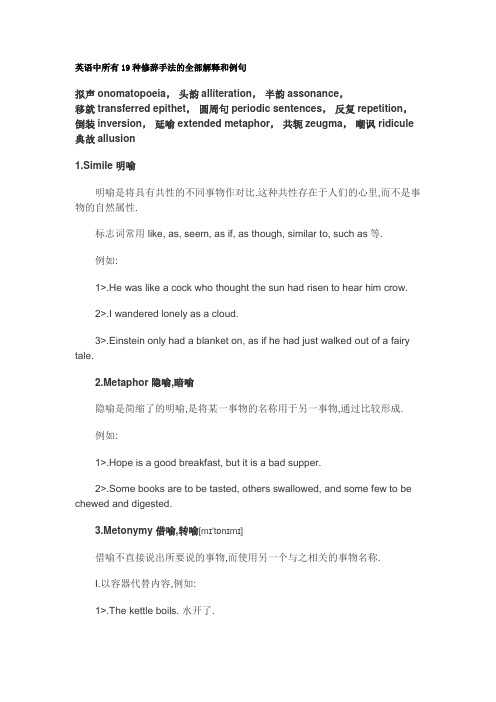
英语中所有19种修辞手法的全部解释和例句拟声onomatopoeia,头韵alliteration,半韵assonance,移就transferred epithet,圆周句periodic sentences,反复repetition,倒装inversion,延喻 extended metaphor,共轭zeugma,嘲讽 ridicule 典故allusion1.Simile 明喻明喻是将具有共性的不同事物作对比.这种共性存在于人们的心里,而不是事物的自然属性.标志词常用 like, as, seem, as if, as though, similar to, such as等.例如:1>.He was like a cock who thought the sun had risen to hear him crow.2>.I wandered lonely as a cloud.3>.Einstein only had a blanket on, as if he had just walked out of a fairy tale.2.Metaphor 隐喻,暗喻隐喻是简缩了的明喻,是将某一事物的名称用于另一事物,通过比较形成.例如:1>.Hope is a good breakfast, but it is a bad supper.2>.Some books are to be tasted, others swallowed, and some few to be chewed and digested.3.Metonymy 借喻,转喻[mɪ'tɒnɪmɪ]借喻不直接说出所要说的事物,而使用另一个与之相关的事物名称.I.以容器代替内容,例如:1>.The kettle boils. 水开了.2>.The room sat silent. 全屋人安静地坐着.II.以资料.工具代替事物的名称,例如:Lend me your ears, please. 请听我说.III.以作者代替作品,例如:a complete Shakespeare 莎士比亚全集VI.以具体事物代替抽象概念,例如:I had the muscle, and they made money out of it. 我有力气,他们就用我的力气赚钱.4.Synecdoche 提喻[sɪ'nekdəkɪ]提喻用部分代替全体,或用全体代替部分,或特殊代替一般.例如:1>.There are about 100 hands working in his factory.(部分代整体)他的厂里约有100名工人.2>.He is the Newton of this century.(特殊代一般)他是本世纪的牛顿.3>.The fox goes very well with your cap.(整体代部分)这狐皮围脖与你的帽子很相配.5.Synaesthesia 通感,联觉,移觉[,sɪnɪs'θiːzɪə]这种修辞法是以视.听.触.嗅.味等感觉直接描写事物.通感就是把不同感官的感觉沟通起来,借联想引起感觉转移,“以感觉写感觉”。
19种英语修辞手法整理
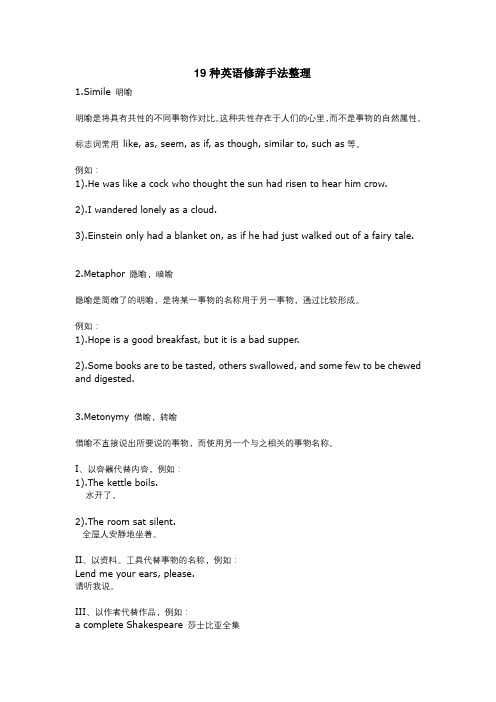
19种英语修辞手法整理1.Simile 明喻明喻是将具有共性的不同事物作对比。
这种共性存在于人们的心里,而不是事物的自然属性。
标志词常用like, as, seem, as if, as though, similar to, such as等。
例如:1).He was like a cock who thought the sun had risen to hear him crow.2).I wandered lonely as a cloud.3).Einstein only had a blanket on, as if he had just walked out of a fairy tale.2.Metaphor 隐喻,暗喻隐喻是简缩了的明喻,是将某一事物的名称用于另一事物,通过比较形成。
例如:1).Hope is a good breakfast, but it is a bad supper.2).Some books are to be tasted, others swallowed, and some few to be chewed and digested.3.Metonymy 借喻,转喻借喻不直接说出所要说的事物,而使用另一个与之相关的事物名称。
I、以容器代替内容,例如:1).The kettle boils.水开了。
2).The room sat silent.全屋人安静地坐着。
II、以资料。
工具代替事物的名称,例如:Lend me your ears, please.请听我说。
III、以作者代替作品,例如:a complete Shakespeare 莎士比亚全集VI、以具体事物代替抽象概念,例如:I had the muscle, and they made money out of it.我有力气,他们就用我的力气赚钱。
4.Synecdoche 提喻提喻用部分代替全体,或用全体代替部分,或特殊代替一般。
英语中有19种修辞手法及英国文学作品与作家
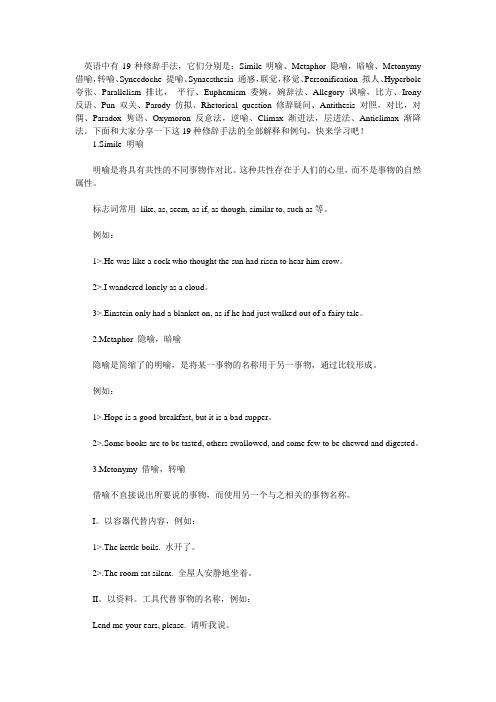
英语中有19种修辞手法,它们分别是:Simile明喻、Metaphor 隐喻,暗喻、Metonymy 借喻,转喻、Synecdoche 提喻、Synaesthesia 通感,联觉,移觉、Personification 拟人、Hyperbole 夸张、Parallelism 排比,平行、Euphemism 委婉,婉辞法、Allegory 讽喻,比方、Irony 反语、Pun 双关、Parody 仿拟、Rhetorical question 修辞疑问、Antithesis 对照,对比,对偶、Paradox 隽语、Oxymoron 反意法,逆喻、Climax 渐进法,层进法、Anticlimax 渐降法。
下面和大家分享一下这19种修辞手法的全部解释和例句,快来学习吧!1.Simile 明喻明喻是将具有共性的不同事物作对比。
这种共性存在于人们的心里,而不是事物的自然属性。
标志词常用like, as, seem, as if, as though, similar to, such as等。
例如:1>.He was like a cock who thought the sun had risen to hear him crow。
2>.I wandered lonely as a cloud。
3>.Einstein only had a blanket on, as if he had just walked out of a fairy tale。
2.Metaphor 隐喻,暗喻隐喻是简缩了的明喻,是将某一事物的名称用于另一事物,通过比较形成。
例如:1>.Hope is a good breakfast, but it is a bad supper。
2>.Some books are to be tasted, others swallowed, and some few to be chewed and digested。
高级英语的十九种修辞和高英1-5课总结张汉熙
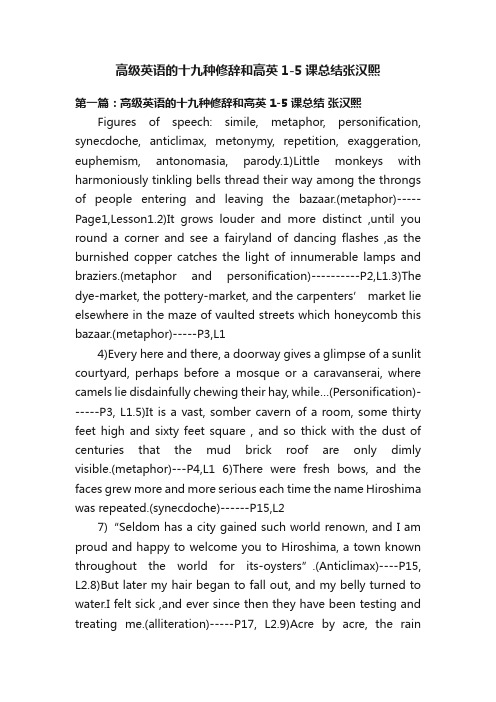
高级英语的十九种修辞和高英1-5课总结张汉熙第一篇:高级英语的十九种修辞和高英1-5课总结张汉熙Figures of speech: simile, metaphor, personification, synecdoche, anticlimax, metonymy, repetition, exaggeration, euphemism, antonomasia, parody.1)Little monkeys with harmoniously tinkling bells thread their way among the throngs of people entering and leaving the bazaar.(metaphor)-----Page1,Lesson1.2)It grows louder and more distinct ,until you round a corner and see a fairyland of dancing flashes ,as the burnished copper catches the light of innumerable lamps and braziers.(metaphor and personification)----------P2,L1.3)The dye-market, the pottery-market, and the carpenters’ market lie elsewhere in the maze of vaulted streets which honeycomb this bazaar.(metaphor)-----P3,L14)Every here and there, a doorway gives a glimpse of a sunlit courtyard, perhaps before a mosque or a caravanserai, where camels lie disdainfully chewing their hay, while…(Personification)------P3, L1.5)It is a vast, somber cavern of a room, some thirty feet high and sixty feet square , and so thick with the dust of centuries that the mud brick roof are only dimly visible.(metaphor)---P4,L1 6)There were fresh bows, and the faces grew more and more serious each time the name Hiroshima was repeated.(synecdoche)------P15,L27)“Seldom has a city gained such world renown, and I am proud and happy to welcome you to Hiroshima, a town known throughout the world for its-oysters”.(Anticlimax)----P15, L2.8)But later my hair began to fall out, and my belly turned to water.I felt sick ,and ever since then they have been testing and treating me.(alliteration)-----P17, L2.9)Acre by acre, the rainforest is being burned to create fast pasture for fast-food beef.(alliteration)-----P30,L310)According to our guide, the biologist Tom Lovejoy, there are more different species of birds in each square mile of the Amazon than exist in all of North America-which means we are silently thousands of songs we have ever heard.(metonymy)----P31,L3.11)What should we feel toward these ghosts in the sky?(metaphor)---P32,L3.12)Have you ever seen a lame animal ,perhaps dog run over by some careless person rich enough to own a car ,sidle up to someone who is ignorant enough to be kind of him?(metaphor)13)And she stops and tries to dig a well in the sand with her toe.(Exaggeration)----P58, L4.14)I feel my whole face warming from the heat waves it throws out.(Exaggeration)15)After I tripped over it two or three times he told me to just call him Hakim-a-barber.(metaphor)-------P60,L4.16)“Maggie’s brain is like an elephant’s”.Wangero said ,laughing.(Ironic)—P62,L4.17)You didn’t even have to look close to see where hands pushing the dasher up and down to make butter had left a kind of sink inthe wood.(metaphor)----P62,L4.18)“Mama,”Wangero said sweet as a bird.“can I have these old quilts?”(Simile)---P63, L4.19)She gasped like a bee had stung her.(simile)20)Churchill, he reverted to this theme, and I asked whether for him, the arch anti-communist, this was not bowing down in the House of Rimmon.(metaphor)21)If Hitler invaded Hell and would make at least a favorable reference to the Devil in the House of Commons.(exaggeration)----P79,L5.22)But all this fades away before the spectacle which is now unfolding.(metaphor)I see also the dull, drilled, docile, brutish masses of the Hun soldiery plodding on like a swarm of crawling locusts.(simile) 24)I see the Russian soldiers standing on the threshold of their native land, guarding the fields which their fathers have tilled from time immemorial.(Metaphor)----P79, L5.25)I see the German bombers and fighters in the sky ,street smarting from many a British whipping to find what they believe is an easier and a safer prey.(Metaphor)---P80, L5.26)We will never parley;we will never negotiate with Hitler or any of his gang.We shall fight him by land, we shall fight him by sea, and we shall fight him in the air.(Parallelism)27)Just as the industrial Revolution took over an immense range of tasks from men’s muscles and enorm ously expanded productivity.(Metonymy)英语中有19种修辞手法,它们分别是:Simile明喻、Metaphor 隐喻,暗喻、Metonymy 借喻,转喻、Synecdoche 提喻、Synaesthesia通感,联觉,移觉、Personification 拟人、Hyperbole 夸张、Parallelism 排比,平行、Euphemism 委婉,婉辞法、Allegory 讽喻,比方、Irony 反语、Pun 双关、Parody仿拟、Rhetorical question 修辞疑问、Antithesis 对照,对比,对偶、Paradox 隽语、Oxymoron反意法,逆喻、Climax 渐进法,层进法、Anticlimax渐降法。
- 1、下载文档前请自行甄别文档内容的完整性,平台不提供额外的编辑、内容补充、找答案等附加服务。
- 2、"仅部分预览"的文档,不可在线预览部分如存在完整性等问题,可反馈申请退款(可完整预览的文档不适用该条件!)。
- 3、如文档侵犯您的权益,请联系客服反馈,我们会尽快为您处理(人工客服工作时间:9:00-18:30)。
英语中有19种修辞手法,它们分别是:Simile明喻、Metaphor 隐喻,暗喻、Metonymy 借喻,转喻、Synecdoche 提喻、Synaesthesia 通感,联觉,移觉、Personification 拟人、Hyperbole 夸张、Parallelism 排比,平行、Euphemism 委婉,婉辞法、Allegory 讽喻,比方、Irony 反语、Pun 双关、Parody 仿拟、Rhetorical question 修辞疑问、Antithesis 对照,对比,对偶、Paradox 隽语、Oxymoron 反意法,逆喻、Climax 渐进法,层进法、Anticlimax 渐降法。
下面和大家分享一下这19种修辞手法的全部解释和例句,快来学习吧!1.Simile 明喻明喻是将具有共性的不同事物作对比。
这种共性存在于人们的心里,而不是事物的自然属性。
标志词常用like, as, seem, as if, as though, similar to, such as等。
例如:1>.He was like a cock who thought the sun had risen to hear him crow。
2>.I wandered lonely as a cloud。
3>.Einstein only had a blanket on, as if he had just walked out of a fairy tale。
2.Metaphor 隐喻,暗喻隐喻是简缩了的明喻,是将某一事物的名称用于另一事物,通过比较形成。
例如:1>.Hope is a good breakfast, but it is a bad supper。
2>.Some books are to be tasted, others swallowed, and some few to be chewed and digested。
3.Metonymy 借喻,转喻借喻不直接说出所要说的事物,而使用另一个与之相关的事物名称。
I。
以容器代替内容,例如:1>.The kettle boils. 水开了。
2>.The room sat silent. 全屋人安静地坐着。
II。
以资料。
工具代替事物的名称,例如:Lend me your ears, please. 请听我说。
III。
以作者代替作品,例如:a complete Shakespeare 莎士比亚全集VI。
以具体事物代替抽象概念,例如:I had the muscle, and they made money out of it. 我有力气,他们就用我的力气赚钱。
4.Synecdoche 提喻提喻用部分代替全体,或用全体代替部分,或特殊代替一般。
例如:1>.There are about 100 hands working in his factory。
(部分代整体)他的厂里约有100名工人。
2>.He is the Newton of this century。
(特殊代一般)他是本世纪的牛顿。
3>.The fox goes very well with your cap。
(整体代部分)这狐皮围脖与你的帽子很相配。
5.Synaesthesia 通感,联觉,移觉这种修辞法是以视。
听.触。
嗅.味等感觉直接描写事物。
通感就是把不同感官的感觉沟通起来,借联想引起感觉转移,“以感觉写感觉”。
通感技巧的运用,能突破语言的局限,丰富表情达意的审美情趣,起到增强文采的艺术效果。
比如:欣赏建筑的重复与变化的样式会联想到音乐的重复与变化的节奏;闻到酸的东西会联想到尖锐的物体;听到飘渺轻柔的音乐会联想到薄薄的半透明的纱子;又比如朱自清《荷塘月色》里的“微风过处送来缕缕清香,仿佛远处高楼上渺茫的歌声似的”。
例如:1>.The birds sat upon a tree and poured forth their lily like voice。
(用视觉形容听觉,鸟落在树上,由它发出的声音联想到百合花)鸟儿落在树上,倾泻出百合花似的声音。
2>.Taste the music of Mozart。
(用嗅觉形容听觉)品尝Mozart的音乐。
6.Personification 拟人拟人是把生命赋予无生命的事物。
例如:1>.The night gently lays her hand at our fevered heads。
(把夜拟人化)2>.I was very happy and could hear the birds singing in the woods。
(把鸟拟人化)7.Hyperbole 夸张夸张是以言过其实的说法表达强调的目的。
它可以加强语势,增加表达效果。
.例如:1>.I beg a thousand pardons。
2>.Love you. You are the whole world to me, and the moon and the stars。
3>.When she heard the bad news, a river of tears poured out。
8.Parallelism 排比,平行这种修辞法是把两个或两个以上的结构大体相同或相似,意思相关,语气一致的短语。
句子排列成串,形成一个整体。
例如:1>.No one can be perfectly free till all are free; no one can be perfectly moral till all are moral; no one can be perfectly happy till all are happy。
2>.In the days when all these things are to be answered for, I summon you and yours, to the last of your bad race, to answer for them. In the days when all these things are to be answered for, I summon your brother, the worst of your bad race, to answer for them separately。
9.Euphemism 委婉,婉辞法婉辞法指用委婉,文雅的方法表达粗恶,避讳的话。
例如:1>.He is out visiting the necessary. 他出去方便一下。
2>.His relation with his wife has not been fortunate. 他与妻子关系不融洽。
3>.Deng Xiaoping passed away in 1997. (去世)10.Allegory 讽喻,比方(原意“寓言”)建立在假借过去或别处的事例与对象之上,传达暗示,影射或者讥讽现世各种现象的含义。
英文解释:an expressive style that uses fictional characters and events to describe some subject by suggestive resemblances; an extended metaphor 摘自英语专业《大学英语教程》一书这是一种源于希腊文的修辞法,意为"换个方式的说法"。
它是一种形象的描述,具有双重性,表层含义与真正意味的是两回事。
例如:1>.Make the hay while the sun shines。
表层含义:趁着出太阳的时候晒草真正意味:趁热打铁2>.It's time to turn plough into sword。
表层含义:是时候把犁变成剑11.Irony 反语反语指用相反意义的词来表达意思的作文方式。
如在指责过失。
错误时,用赞同过失的说法,而在表扬时,则近乎责难的说法。
例如:1>.It would be a fine thing indeed not knowing what time it was in the morning。
早上没有时间观念还真是一件好事啊(真实含义是应该明确早上的时间观念)2>"Of course, you only carry large notes, no small change on you. "the waiter said to the beggar。
12.Pun 双关双关就是用一个词在句子中的双重含义,借题发挥。
作出多种解释,旁敲侧击,从而达到意想不到的幽默。
滑稽效果。
它主要以相似的词形。
词意和谐音的方式出现。
例如:1>.She is too low for a high praise, too brown for a fair praise and too little for a great praise。
2>.An ambassador is an honest man who lies abroad for the good of his country。
3>.If we don't hang together, we shall hang separately。
13.Parody 仿拟这是一种模仿名言。
警句.谚语,改动其中部分词语,从而使其产生新意的修辞。
例如:1>.Rome was not built in a day, nor in a year。
2>.A friend in need is a friend to be avoided。
3>.If you give a girl an inch nowadays she will make address of it。
14.Rhetorical question 修辞疑问(反问)它与疑问句的不同在于它并不以得到答复为目的,而是以疑问为手段,取得修辞上的效果,其特点是:肯定问句表示强烈否定,而否定问句表示强烈的肯定。
它的答案往往是不言而喻的。
例如:1>.How was it possible to walk for an hour through the woods and see nothing worth of note?2>.Shall we allow those untruths to go unanswered?15.Antithesis 对照,对比,对偶这种修辞指将意义完全相反的语句排在一起对比的一种修辞方法。
